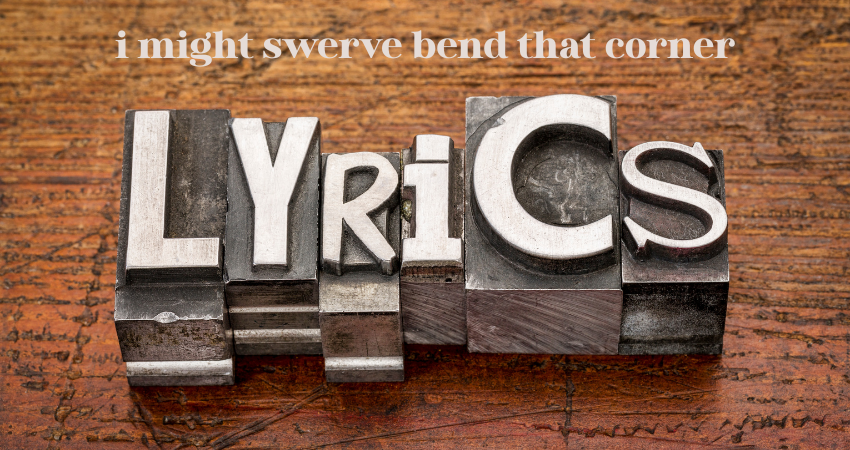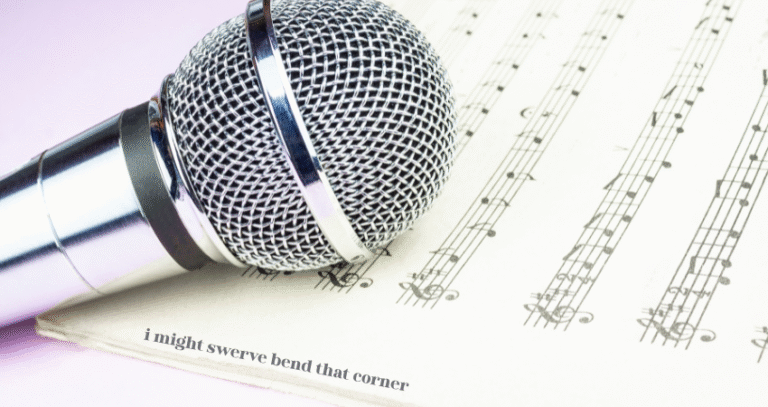Mastering song lyrics isn’t just about repeating words—it’s about diving deep into the cultural, emotional, and artistic currents that shape them. “I might swerve bend that corner lyrics” isn’t your typical catchy hook; it’s a phrase packed with swagger, rhythm, and streetwise attitude. In this ultimate guide, we’ll peel back the layers, explore what makes these lyrics so magnetic, and give you actionable steps to truly own them. Whether you’re a casual listener, aspiring rapper, or a music enthusiast fascinated by lyrical craft, this guide is your road map. Get ready to explore meanings, techniques, and creative approaches that go far beyond reciting lines. By the end, you won’t just know the words—you’ll feel them, live them, and maybe even bend your own lyrical corners.
Introduction to the Phenomenon
The Rise of the Phrase in Urban Culture
The phrase “i might swerve bend that corner lyrics” didn’t just pop up overnight; it’s a product of years of street slang evolution and the creative minds in hip-hop and urban music. Think about how urban slang works—it’s always fluid, always in motion, bending language just like you’d bend a corner in a fast car. This phrase, in particular, embodies rebellion, freedom, and quick decision-making. It’s about taking your own route, ignoring the straight road, and showing style while doing it.
Over time, it has moved from being a raw, underground expression into something echoed on TikTok, Instagram captions, and viral videos. People relate to its attitude—it’s defiance wrapped in rhythm. In many ways, it mirrors how young people feel: needing to improvise, react quickly, and make moves that might not always look safe or planned but feel authentic.
Cultural shifts, social media trends, and meme culture have amplified this phrase beyond music. It’s become part of a larger language of flexing and self-expression, making it resonate from gritty rap battles to polished playlists. It symbolizes confidence and unpredictability—the two cornerstones of modern urban storytelling.
Why These Lyrics Resonate with So Many
Lyrics often stick because they speak a universal truth in a fresh way. “I might swerve bend that corner” is more than a boast—it’s a mindset. It’s the thrill of risk, the charm of unpredictability, and the claim of control over your path. At some point, everyone faces a metaphorical corner they must bend, a moment they must decide to swerve or stay the course.
Fans connect because it mirrors real-life situations: switching careers, taking a relationship risk, or stepping into the unknown. It’s short, catchy, and leaves space for personal interpretation. You don’t have to be from the same streets or background to get it—you just need to have felt the rush of making a bold choice.
In a world obsessed with authenticity, these lyrics cut through. They don’t sound scripted or polished; they sound like someone thinking out loud in a moment of adrenaline. That rawness, that openness to possibility, keeps them playing in people’s heads long after the beat stops.
Understanding the Meaning Behind the Lyrics
Breaking Down “I Might Swerve”
At first glance, “swerve” sounds like a driving term—and it is. But in urban slang, to “swerve” means more than just turning the wheel. It means avoiding obstacles, dodging negativity, or making a sudden change in direction to stay true to yourself. It’s about control, style, and survival.
Picture this: you’re driving fast, music blasting, and something appears in your lane. You swerve—not out of panic but skill, experience, and instinct. That’s what the lyric embodies: not recklessness, but mastery over unpredictability. It suggests the artist isn’t stuck on one track; they can shift, pivot, and keep moving without losing momentum.
Beyond cars, “swerve” has also grown to mean dismissing haters, skipping drama, or moving away from anything that threatens your peace or progress. That’s why the phrase resonates: it’s both literal and deeply figurative, a single word capturing a whole philosophy.
Exploring “Bend That Corner”
“Bend that corner” adds more flavor to the picture. It evokes the image of speeding through tight streets, bending corners sharply yet gracefully. In hip-hop culture, it reflects navigating tough situations while keeping your swagger. It shows fearlessness—approaching challenges not by slowing down but by leaning in.
This part of the phrase brings energy and local flavor. It’s rooted in urban landscapes where street racing, drifting, and bike culture thrive. Bending a corner isn’t just about movement—it’s about doing it with style, making the impossible look effortless.
The lyric becomes even more powerful because it combines raw speed with control. Anyone can drive fast, but bending a corner takes practice, confidence, and a feel for rhythm—just like spitting bars or flowing over a beat.
The Deeper Symbolism and Street Slang Roots
Street slang often says more than meets the ear. Here, “swerve” and “bend that corner” both symbolize adaptability, resilience, and living life on your terms. Together, they form a message: don’t just react—anticipate. Don’t just follow the road—shape it.
The roots come from real urban experiences—cruising, racing, dodging trouble, or staying two steps ahead of danger. Over time, artists took these literal images and turned them into metaphors for life itself: relationships, hustle, and the constant dance between risk and reward.
That’s why the lyrics feel alive—they’re built from lived experience and cultural nuance. Mastering them means understanding this layered meaning, not just repeating the words.

The Song’s Origins and Cultural Context
Artist Background and Influence
The artist behind the phrase brought not just words but lived authenticity. Their music reflects the pulse of their city—fast, raw, and unpredictable. Influences likely range from West Coast cruising anthems to Southern trap, blending car culture with wordplay.
The artist’s background often shapes how lyrics sound and what they mean. If they grew up surrounded by street racing, cruising, or freestyle battles, it makes sense that metaphors like “swerve” and “bend that corner” flow naturally. The delivery isn’t forced—it’s storytelling rooted in environment.
Fans don’t just hear the words—they sense the artist’s journey. That’s what makes the lyrics stick: it’s someone painting scenes from a life they’ve really lived.
When and How the Song Gained Popularity
The song’s rise wasn’t overnight. It likely started on mixtapes, local shows, or freestyle clips before exploding online. Social media, streaming playlists, and viral dance challenges have a way of turning underground gems into mainstream hits.
“I might swerve bend that corner” became catchy because it’s short, rhythmic, and adaptable to memes, captions, and remixes. Listeners clipped the hook, remixed it, and made it part of digital culture, giving it a life beyond the original track.
The lyric became both an anthem and an attitude—a soundtrack for moments when you decide to take a risk, change lanes, or prove doubters wrong.
Impact on Modern Music and Memes
Once a lyric catches fire, it jumps from music into internet culture. Memes featuring the phrase popped up everywhere, from drifting car GIFs to jokes about avoiding responsibilities. The lyric’s flexible meaning—literal and metaphorical—makes it meme gold.
Other artists picked up on the style too, dropping similar lines or flipping the concept. It influenced how rappers approach hooks: keep it catchy, visual, and relatable, but also leave space for interpretation.
This ripple effect shows the power of great lyrics: they don’t just fill a verse—they spark creativity across music, social media, and everyday conversation
Mastering the Lyrics Step by Step
Memorization Techniques
Learning lyrics like “I might swerve bend that corner” isn’t about cramming words—it’s about making them part of your rhythm. Start by breaking the lyrics into small sections. Focus on the hook first because it’s the heartbeat of the song and usually the easiest to remember. Repeat it slowly, then gradually speed up until it feels natural.
Next, write the lyrics down by hand. This old-school method works wonders because writing reinforces memory through muscle movement. While you’re at it, speak the words aloud. Hearing yourself creates an audio loop that strengthens recall.
Create flashcards or digital notes with tricky lines. Review them during short breaks—on the bus, waiting in line, or before bed. Short, frequent sessions beat marathon study sessions every time.
Finally, pair the lyrics with the beat. Play the instrumental on repeat and rap along. Your brain loves patterns, and the rhythm becomes a mental anchor. Over time, the words won’t just be in your head—they’ll flow from muscle memory, making them easier to recall even under pressure.
Using Visualization to Lock in Words
Visualization transforms words into living pictures. Imagine yourself literally swerving down a neon-lit street and bending sharp corners at full speed. Visual cues stick in memory far longer than plain text.
Picture every line of the song as a scene in a short movie. What do the streets look like? What car are you driving? What’s the energy in the air? Adding vivid colors, sounds, and even imagined smells locks each lyric deeper into your mind.
It also helps to link words to movements. Try gesturing as you rap—like mimicking a steering wheel when you say “swerve.” These physical cues work like bookmarks in your brain.
Visualization doesn’t just help you remember; it makes your performance come alive. Audiences love energy, and imagining real scenes adds an authentic vibe to your delivery. It’s like acting out a story rather than reciting lines—and that difference is what makes someone memorable.
Practicing with Friends and Freestyling
Lyrics aren’t meant to live on a screen—they’re meant to be shared. Practicing with friends transforms memorization into performance. Plus, friends notice things you might miss, like unclear pronunciation or awkward timing.
Turn practice into a game. Challenge each other to rap the lyrics faster each round, swap lines, or freestyle new verses in between. This keeps practice fun and builds confidence.
Freestyling around the hook “I might swerve bend that corner” is a powerful exercise. Improvise new lines that rhyme or expand on the theme. You’ll deepen your understanding of the original lyrics and discover your unique voice in the process.
Perform in front of a mirror, record yourself, or even go live on social media for feedback. The more you practice, the more comfortable and natural the lyrics feel. Over time, they stop being “memorized words” and start becoming part of your own expression.

Adding Your Own Flavor
Personal Interpretation and Remix Ideas
Lyrics aren’t set in stone—they’re i might swerve bend that corner lyrics, breathing stories you can reshape. Think about what “swerve” and “bend that corner” mean in your life. Maybe it’s about skipping negativity, switching careers, or navigating a tough friendship.
Write new verses inspired by the original hook. How would you tell your story using the same vibe? This isn’t just rewriting—it’s remixing, a core tradition in hip-hop culture.
You could add a regional twist. If you’re from a coastal city, maybe the corner is by the beach. If you’re from the countryside, maybe it’s a dirt road. Localization makes the lyrics yours and creates authenticity listeners can feel.
Remix ideas also include flipping the perspective. Instead of “I might swerve,” what if it’s about when you didn’t swerve—and what happened next? Or what if the corner bends you, not the other way around? Playing with perspectives adds depth and creativity to your performance.
Creative Ways to Perform the Lyrics
Performance isn’t just voice—it’s i might swerve bend that corner lyrics. Add body language to emphasize the words. Lean forward on “swerve,” twist your shoulders on “bend that corner,” or use facial expressions to tell the story.
Try switching the tempo. Slow down the hook to highlight the words or double-time your verses for an adrenaline rush. You can even perform acapella first to focus on raw delivery, then add the beat later.
Incorporate call-and-response when performing for a crowd. After rapping “I might swerve,” pause and let the audience shout back “bend that corner!” This interaction transforms listeners into participants, creating an electric atmosphere.
Experiment with backing tracks, remixes, or live instruments. A guitar riff, piano chords, or even beatboxing can bring fresh life to familiar words.
Blending Styles and Genres
Don’t stop at hip-hop—push the boundaries. Imagine mixing the lyrics with an R&B hook, a reggae beat, or an electronic drop. The original words are flexible enough to live in different soundscapes.
Collaborate with artists i might swerve bend that corner lyrics your usual style. A singer could harmonize over “swerve,” or a DJ could layer in samples from old-school soul or rock. Each blend uncovers a new dimension of the lyrics.
Blending styles isn’t just about sound—it’s about expanding the audience. Someone who never listened to rap might connect when the hook plays over an acoustic guitar.
Creative blending keeps the lyrics alive and proves one thing: music isn’t about walls; it’s about doors—and every remix is a new room to explore.
Common Mistakes and How to Avoid Them
Mispronunciations and Slang Misuse
Slang is powerful—but tricky. Mispronouncing or misusing words like “swerve” can shift the vibe from authentic to awkward. Before performing, listen carefully to how the original artist delivers each syllable.
Record yourself and i might swerve bend that corner lyrics. Notice the cadence, pauses, and emphasis. Are you dropping syllables naturally, or forcing them? The goal isn’t mimicry—it’s clarity.
Understand the meaning before you rap. If “swerve” means avoiding negativity, don’t use it in a verse that contradicts that spirit. Listeners pick up on mismatches, even subconsciously.
If you’re using slang from a culture or city different from your own, do your homework. Respect and understanding keep your performance genuine and avoid unintentional offense.
Overthinking vs. Flowing Naturally
One of the biggest traps: thinking too hard. When you rehearse endlessly, your performance can sound robotic. Music lives in the balance between preparation and spontaneity.
After you’ve memorized the lyrics, let go. Trust the muscle memory built from repetition. Focus on the emotion rather than perfect pronunciation. Feel the rhythm instead of counting beats in your head.
Imagine telling a story to a friend rather than reciting a poem. Mistakes might still happen—but realness matters more than perfection. Audiences forgive slips if they feel your passion.
Practice breathing techniques to stay relaxed. Inhale before the hook, exhale on the beat. It keeps your delivery smooth, your mind clear, and your voice strong.
